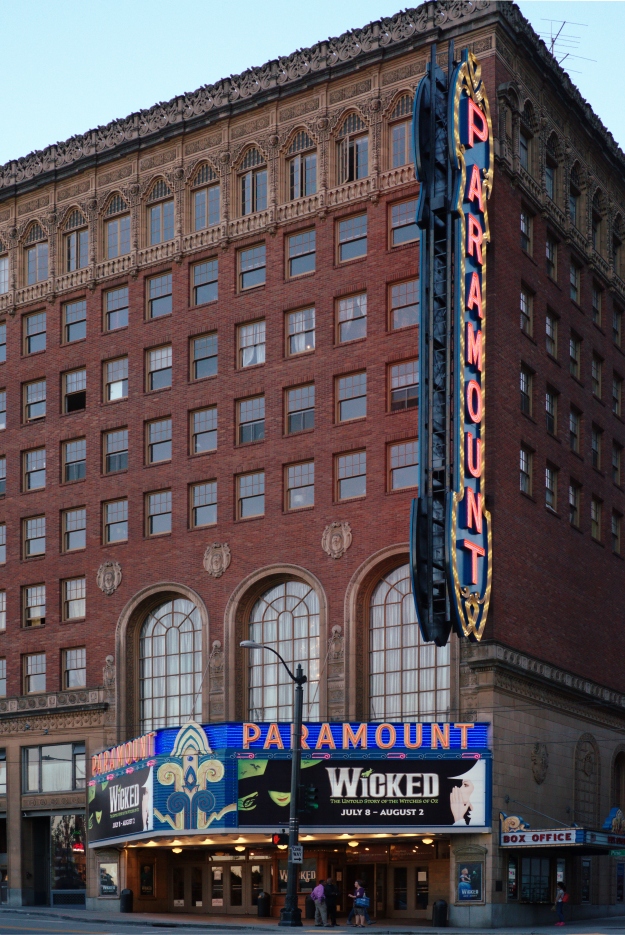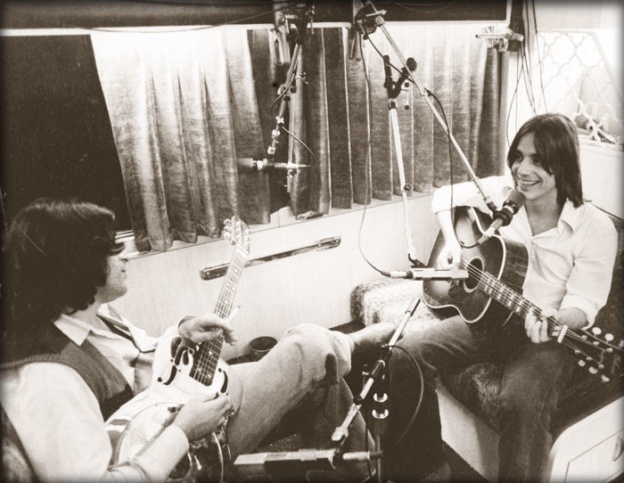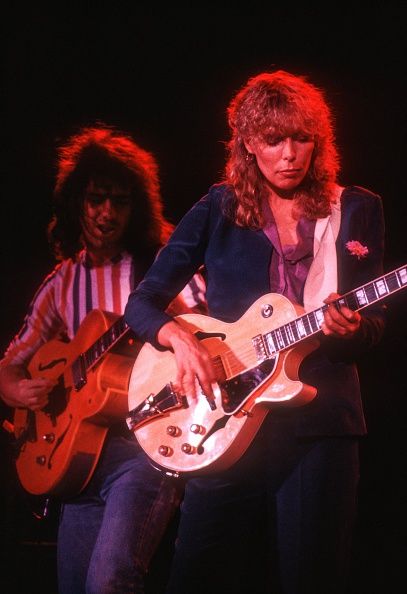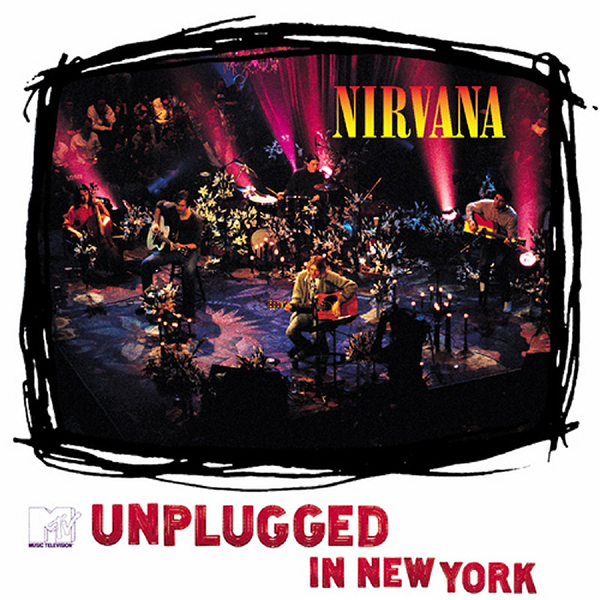Here’s one I really go back a long way with. Don’t worry – I do have a couple of posts planned on artists I didn’t write about this time last year.
Shortly before the release of Nevermind in September 1991, Nirvana began a tour of theatres and clubs in North America, culminating in three West Coast shows with Mudhoney in Portland, Vancouver and their hometown of Seattle, where they were joined by Bikini Kill. They played their homecoming show at the Paramount Theater in Seattle on Halloween, Thursday 31 October.
The show was filmed (on 16mm cameras) and recorded for possible future release, and the audio was bootlegged for years. I swapped my old Nintendo Gameboy for a copy in, I don’t know, 1996 maybe, which tells you a) how old I am, and b) how long the bootlegs were doing the rounds before Interscope Geffen A&M finally released it on DVD, Blu-Ray and CD in 2011, on the DGC imprint for old time’s sake.
Of course, bootlegs of the other shows from the tour are probably available if you look hard enough, but the Paramount show was a special one for the band, who were still having a blast and hadn’t yet hit a level of fame that they couldn’t deal with, and it’s the only one that was recorded properly with high-budget gear and mixed by Andy Wallace. Whether the band were in such transcendent form as this in Portland and Vancouver, I couldn’t tell you. But at the Paramount, they were really something else.
As the gig begins, Cobain seems in an unusually good mood. He wishes the crowd happy Halloween, before introducing the first song as being by a band from Edinburgh, Scotland, who are “very punk rock” (in Cobain’s world, the highest praise that can be bestowed).
I’ve written before about my impatience with Nirvana’s cover of The Vaselines’ Jesus Doesn’t Want Me for a Sunbeam, and the electric arrangement the band were playing in 1991 does even less for me than the Unplugged version, which at least had the novelty of Krist Novoselic playing accordion. What you can hear, though, is a throat-tearing intensity from Cobain from the off, a really good guitar sound (not always the case for Cobain live – sometimes his guitar sounded a bit rubbish. Here, especially, when playing his humbucker-equipped Fender Jaguar, it sounds amazing) and excellent sound quality. This is what good gear and a pro mixer can do for you.
Dave Grohl’s last cymbal crash hasn’t died away before Cobain breaks into the opening riff of Aneurysm. This is one of the greatest live versions of the B-side and fan favourite, and the intensity is palpable. Grohl is clearly giving the drums a mighty pounding (dig the way he smacks both his crash cymbals and keeps time with huge smacking quarter notes as Cobain plays the ascending part at the end of the intro; he addresses the brass like a boxer working the speed bag), and if you watch the video, you’ll see Cobain and Novoselic throwing themselves around the stage like marionettes being pulled by their strings. It’s as if the music’s playing them, not the other way round.
Then there’s the sound of Cobain’s voice during this era, before the constant screaming took it’s toll on his throat. Jayson Greene wrote well about the Cobain’s vocals in his review of the album for Pitchfork:
He sang in a way that was obviously unsustainable, even with the aid of heavy cough syrup, and there’s a thrill, although a slightly selfish one, of hearing his voice rip the air before he had begun to scream it down to the threads. His peculiar, yowling phrasing may have been a deliberate choice, or it might have been the only way he managed to wrangle those notes from a constricted voice box, but there is a terrible, riveting intensity to it: Words feel torn from him, bearing fishhooks on their way out. “Aneurysm”‘s “Love you so much/ It makes me sick” becomes “Laahve yeww sowl much et makes me SECK.” It physically hurts to hear, as it always has, but it gives you some of the most committed, clear performances of Nirvana’s canonical songs as you’re likely to get.
There’s a thing I value in some recordings that seems to me somewhat overlooked by many music fans. I suspect it’s something that musicians themselves value more than fans and it’s probably controversial idea anyway, because it takes us into the realms of an individual’s own subjective experiences, memories and perceptions, but I love when a recording really truly sounds like the thing being recorded. It’s much rarer than you might think. I love drum sounds that sound and feel like my own experience of having sat behind a drum kit, listening to myself give a snare drum a good solid clonk, with my ears maybe two feet away. Or what it sounds like to be in a rehearsal room with a drummer, my ears at about the level of the cymbals and have them swirling around me. I love recordings of electric guitars that capture the full frequency range, that slight sag of a tube amp being pushed hard. These types of recordings feel alive to me.
Live recordings are more likely to convey some of this sense memory than studio recordings, at least since the late 1970s. I once heard Ron Saint Germain say that once production gets beyond the initial bass and drums tracking, it’s the beginning of the shrinking process. A really well produced record, like for example Nevermind, may sound great, but it will have lost at least some of the power that was there when the band played in the room. You sacrifice size for detail.
Live at the Paramount retains a lot of size, a lot of power – more than even most live albums – and it can make you hear songs as if for the first time again. Drain You, the third song in the set, is like that for me. It’s not a song I tend to seek out much these days, and not one of my favourites on Nevermind. But here it’s such a thrilling mix of rawness – the force of Grohl’s kick drum, the dynamics of the noise section in the middle as Grohl plays those 8th-note build-ups and Cobain wrestles with his Jaguar – and sheer melodic and harmonic craft (the way the unconventional chord changes are totally justified and reinforced by the vocal melodies and Grohl’s harmonies) that it connects me back to how I felt about this band at the age of 12 or 13. It also shows that, if we needed reminding, the band’s members were craftsmen, not the primitives they liked to paint themselves as in interviews.
But, as if to show the crowd that they still enjoy playing up that image, the band follows Drain You with two cuts from Bleach, School and Floyd the Barber, the former getting a huge sweaty roar of approval as soon as Cobain plays the intro. Grohl is a pretty good double for Melvins drummer Dale Crover on the latter (though why he didn’t sing the prominent harmonies on the song’s chorus is a bit of a mystery – sure he had a lot on his plate already learning his predecessers’ parts on the early material, but they’re really quite obvious and do improve the song), and if he doesn’t replicate the double-kick-powered groove that Chad Channing played on School, he is a lot more steady, and the song doesn’t quite threaten to come apart at any moment as it does on the Bleach recording.
On later tours, Nirvana could play Smells Like Teen Spirit as if it were a painful duty, or not play it at all, but in autumn 1991 they were still giving their performances of it everything they had. They take it a quick tempo, with Grohl smashing the life out of his cymbals and playing every fill with authority and power. Cobain’s voice gets increasingly ragged with every chorus, and on the final held “a denial” it gives way entirely. While the studio recording works so well because of the tension between the song’s message and the polished presentation of that message, live versions from this era strip that gloss away, leaving edges jagged enough to cut yourself on. You hear it as the alien interloper within mainstream rock that it always was.
About a Girl is also taken briskly, so much so that Grohl pulls them back to a more workable tempo after he comes in. Listened to in conjunction with Teen Spirit, the two songs seem to end up in a similar place via different routes: on Teen Spirit, the band strip the song down to its rawest essentials, spotlighting the adrenalized, punky side of themselves; on About a Girl, they inject into it an energy and spirit that wasn’t there on Bleach, giving it greater edge and making it sit naturally with songs like Teen Spirit.
Polly is an extraordinary song, if you can strip away your familiarity with it to hear it as if for the first time. Sung from the point of view of a man abducting and raping a teenage girl, it’s a harrowing listen – the more so because it’s one of the softest pieces Cobain ever wrote. Yet, playing it straight, without going into a big rock ‘n’ roll chorus, Cobain keeps the crowd completely engaged. His willingness to explore these kinds of subjects, to speak up for causes that mainstream rock musicians wouldn’t go near, is an inextricable part of Nirvana’s greatness and importance, and you could easily make a case that he didn’t write a more important song than Polly. As Bob Dylan remarked after hearing it, the kid had heart.
Breed is a series of explosions, a frenzy of drum rolls and power chords, but with a pin-sharp melody that won’t leave you alone. The band play it with precision. Like In Bloom, which Dave Grohl has explained is him playing drum parts devised by Chad Channing, Breed was first demoed before Grohl joined the band. While Grohl’s drumming on the song is its most crucial musical feature, it’s worth remember that the parts he’s playing are Channing’s, and that he deserves a lot of the credit.
Sliver has an important place in the band’s history. Released in 1990, and the only song in the Nirvana canon to feature Mudhoney’s Dan Peters on drums, Sliver was self-consciously written as a break with the band’s Bleach-era songs, said Cobain: “I decided I wanted to write the most ridiculous pop song I had ever written to prepare people for the next album.” Thing is, that places more weight on the song than, for me, it can bear. It’s a trifle, paling next to even the least of Nevermind‘s songs. Whether on Incesticide or in a live performance, it never feels substantial to me, and coming between the casual brilliance of Breed and the band’s genuinely thrilling update of Shocking Blue’s Love Buzz doesn’t help it.
The studio recording of Love Buzz is mostly about the bass and guitar, and features possibly Cobain’s finest solos on record. Live, his playing was always scrappier, and he tended to adapt the pull-off riff to make it simpler to play. This version, it’s Novoselic and Grohl who impress most. Novoselic gets plenty of space during the mono-chordal solo to explore the upper reaches of his fretboard, while Grohl playing Channing’s parts is, again, a revelation. There was always something of the funk drummer in Grohl – a propensity to absolutely explode on the one, with huge cymbal crashes and a mighty kick drum. You can hear that – and on the DVD or Blu-Ray see it – here. A particular Grohl tic is to hit both his crashes simultaneously on the one for added power and excitement, and it sounds so right here: every huge open A chord reinforced by an explosion from Grohl’s cymbals. It’s so much fun.
Lithium is a mixed bag. The choruses sound great, but the verses are a bit messy, with Novoselic’s bass feeling like it’s behind the beat, or at least behind the guitar. It’s a bit of a shame. I’m not sure who the guilty party is but it does undermine the performance a bit if you’re listening at home; the folks in the audience may not have been aware of it.
Been a Son is one of Nirvana’s best minor works. Recorded by Steve Fisk for the Blew EP with Chad Channing on drums, then re-recorded with Grohl at a faster tempo for a BBC session (the version that’s on Incesticide), it has great mid-sixties John Lennon harmonies, here supplied by Grohl, and a really cool semi-distorted and flanged bass guitar sound. Written in 1987, it may have been Cobain’s earliest feminist statement, but its pithiness is still effective. Its verses are a laundry list of things the unnamed girl “should” have done but didn’t, before her disappointed parents simply state in the chorus that she should have been a son. This ability that Cobain had to distil a message is still underrated, as some of his lyrics work essentially as collage and resist line-by-line readings of them. When he wanted to make a simple point, he could do it as well as anyone.
(Sidenote: why is it that the similarly melodically simple Sliver kind of annoys me, while I think Been a Son is great? I wish I could expain it. The harmonies maybe.)
Next, after some screaming feedback, Cobain launches into Negative Creep. This is a fascinating one. There’s a quality to the original that I love: it’s incredibly claustrophobic and heavy, but as with so much early Nirvana, the band (especially Channing) are barely in control. That increasing sense that they are only just hanging together is mirrored in Cobain’s vocal, which gets more hysterical and ragged with every verse. It’s great, but it’s so over the top it’s a little comedic.
Live, Cobain’s vocal doesn’t have the same mounting hysteria. He sort of manages to get the notes out, but the effort is clear, and by this point in the gig his voice is starting to get a little thin and tired-sounding. So while the song gains a lot from Grohl’s brutal but very controlled performance, it suffers a little in comparison with the studio cut, which is basically made by Cobain’s crazy vocal.
No such issues exist with On a Plain, one of Nevermind‘s most uncomplicatedly pop songs, complete with middle eight and prominent harmonies. It’s basically a piece of rather meta (lyrics about writing lyrics, and in-jokes between the band members) power pop, buoyed by a bouncy bass line from Novoselic and a brilliant, very composed drum performance from Grohl – every fill is just so, all repeated until they become just as much a part of the song as the chord changes and melody. The band are perfect, and give the impression they could do this in their sleep. It’s really impressive.
The set ends with Blew. The first track off Bleach, it can’t help but sound a little rudimentary next to On a Plain, but the crowd clearly love it, and the band, particularly Cobain, invest it with a lot of fire – his solo is nicely squonky, with loads of energy.
The encore begins with an early version of Rape Me. “This song is about hairy, sweaty, macho redneck men,” Cobain explains, before adding, “who rape.” Some critics (Michael Azzerad in his book Come as You Are, for example) have seen the song as a comment on his own media notoriety, but given that he’d already written it in late 1991, before he had become a household name and before any unflattering press coverage, that reading should be resisted. It is what it appears to be – a condemnation of rape culture. What’s striking, hearing it in 2020, is the lyric Cobain sings in the chorus: “I’m not the only one”. In other words, “me too”. Cobain’s repeated cries of “rape me” at the end of the song are hair-raising.
Territorial Pissings is taken at an absolutely furious tempo, before collapsing into a version of Endless Nameless to finish the gig off. If the encore is a little anticlimactic, it’s only because the band have blown through 16 of their best songs in the set proper and don’t have much left except a noise jam, a new song and a punky thrash. It’s fine, but the magic has already happened.
And what magic it is. Live at the Paramount captures Nirvana at the early peak of their powers. You could argue that the Reading set from 1992 is as good or better – I wouldn’t want to take sides – but this one’s my favourite. I first heard it in full when I was about 14, and didn’t hear the Reading set in full until much later, so I’m more sentimentally tied to this one.
The energy throughout the whole thing is so infectious that the album totally transcends the issues that sometimes negatively affect live albums, especially rock records. When you’re not there in the room with the band and the audience, flubs and missed notes and the rawness of the moment are obviously all more noticeable, and they can distance you from the song. The Paramount gig is raw: over the course of the show, Cobain’s voice becomes tired; in the loudest sections, his and Novoselics’s propensity to throw themselves around means they make mistakes and are not as tight as on record.
None of that matters. Tehcnical proficiency was never what the band were about anyway. What matters is the fire, the passion, with which they played their songs, the connection they forged with their fans by being so human up there, and the way melody and power were welded together by Cobain’s white-hot guitar.

The Paramount Theatre. Last September, Mel and I spent four nights in Seattle. We had a packed itinerary and didn’t have time for me to go looking for venues, but in the course of our wanderings we chanced upon The Crocodile, the Tractor Tavern, the Showbox, the Comet Tavern, Neumos – maybe more that I’m forgetting. Seeing the Paramount on our way to dinner at Quinn’s Pub in Capitol Hill was a genuine “oh it’s you!” moment.




